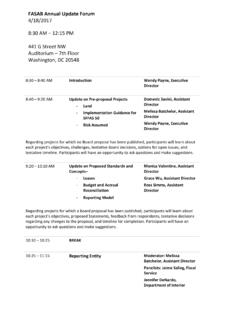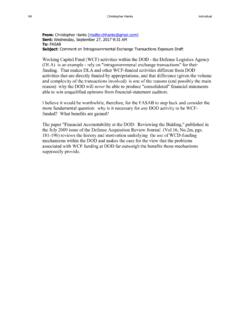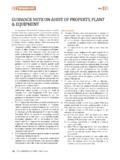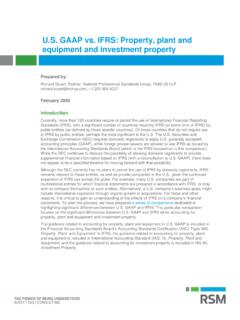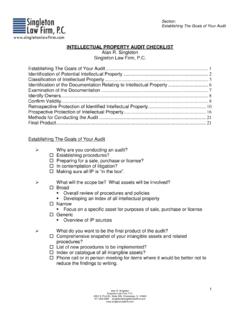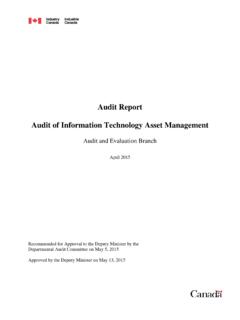Transcription of Status - FASAB
1 Statement of Federal Financial Accounting Standards 5: Accounting for Liabilities of The Federal Government Status Issued December 20, 1995. Effective Date for fiscal years beginning after September 30, 1996. Interpretations and Technical Interpretation 2, Accounting for Treasury Judgment Fund Transactions Releases Interpretation 3, Measurement Date for Pension and Retirement Health Care Liabilities Interpretation No. 4, Accounting for Pension Payments in Excess of Pension Expense TR 1, Audit Legal Letter Guidance TR 2, Environmental Liabilities Guidance TR 12, Accrual Estimates for Grant Programs Affects SFFAS 1, by amending the definition of liability.
2 Affected by SFFAS 7, paragraph 36(b), affects SFFAS 5, paragraphs 35-42. (Contingencies), by creating an exception to the general principles for losses on contracts for goods made to order or services produced to order. SFFAS 8, paragraphs 116 & 117 affect SFFAS 5, paragraphs 6, 104 and 105. SFFAS 12 affects SFFAS 5, paragraphs 33 and 36, by changing the recognition criteria for recognizing liabilities arising from litigation. SFFAS 17 affects SFFAS 5, by providing accounting guidance for social insurance contrary to statements in SFFAS 5, paragraphs 6, 104, and 105.
3 Interpretation 3 affects SFFAS 5, paragraphs 56-76, by clarifying that the measurement of pension and health care liabilities in general purpose federal financial reports does not have to be based on a full actuarial valuation as of the end of the reporting period. Interpretation 4 affects SFFAS 5, paragraphs 71, 74, and 75, by providing accounting guidance for the expectional circumstance where the employer entity's total payments for FERS and CSRS exceed the related total pension expense. SFFAS 5 provides for the normal circumstance where the pension expense is equal to or more than the entity's payment to the administrative entity.
4 SFFAS 25, paragraph 4, affects SFFAS 5, paragraph 106, by classifying risk assumed information as Required Supplementary Information (RSI) instead of Required Supplementary Stewardship Information (RSSI). The Executive Summary is also affected. SFFAS 32 amends paragraphs 117 and 121. SFFAS 33 amends paragraphs 65, 66, 83, 95 and 157. SFFAS 39 amends footnote 17. SFFAS 51 rescinded paragraphs 97-121. TB 2017-1 clarifies SFFAS 5 regarding intragovernmental exchange transactions. SFAS 54 rescinds paragraphs 43-46. Page 1 - SFFAS 5 FASAB Handbook, Version 17 (06/18).
5 SFFAS 5. Summary This Statement establishes accounting standards for liabilities of the federal government not covered in Statement of Federal Financial Accounting Standards 1, Accounting for Selected Assets and Liabilities, and in Statement of Federal Financial Accounting Standards Number 2, Accounting for Direct Loans and Loan Guarantees. This Statement defines liability as a probable future outflow or other sacrifice of resources as a result of past transactions or This Statement defines the recognition points for liabilities associated with different types of events and transactions (See Figure 1 on page 6).
6 2. A liability arising from reciprocal or exchange transactions ( , transactions in which each party to the transaction sacrifices value and receives value in return) should be recognized when one party receives goods or services in return for a promise to provide money or other resources in the future ( , a federal employee performs services in exchange for compensation). A liability arising from nonreciprocal transfers or nonexchange transactions ( , transactions in which one party to the transaction receives value without directly giving or promising value in return, such as grant and certain entitlement programs) should be recognized for any unpaid amounts due as of the reporting date.
7 The liability includes amounts due from the federal entity to pay for benefits, goods, or services3 provided under the terms of the program, as of the federal entity's reporting date, whether or not such amounts have been reported to the federal entity ( , estimated Medicaid payments due to health providers for service that has been rendered and that will be financed by the federal entity but have not yet been reported to the federal entity). Government-related events are nontransaction-based events that involve interaction between federal entities and their environment.
8 The event may be beyond the control of 1. Liabilities recognized according to the standards in this Statement include both liabilities covered by budgetary resources and liabilities not covered by budgetary resources. Liabilities covered by budgetary resources are liabilities incurred that will be covered by available budgetary resources encompassing not only new budget authority but also other resources available to cover liabilities for specified purposes in a given year. Liabilities not covered by budgetary resources include liabilities incurred for which revenues or other sources of funds necessary to pay the liabilities have not been made available through congressional appropriations or current earnings of the reporting entity.
9 Notwithstanding an expectation that the appropriations will be made, whether they in fact will be made is completely at the discretion of the Congress. (Adapted from OMB Bulletin No. 94-01, Form and Content of Agency Financial Statements. ). 2. Recognition means reporting a dollar amount on the face of the basic financial statements. 3. Goods or services may be provided under the terms of the program in the form of, for example, contractors providing a service for the government on the behalf of the disaster relief beneficiaries. Page 2 - SFFAS 5 FASAB Handbook, Version 17 (06/18).
10 SFFAS 5. the entity. A liability is recognized for a future outflow of resources that results from a government-related event when the event occurs if the future outflow of resources is probable and measurable (see paragraphs 33 and 34 for the definitions of probable and measurable, respectively) or as soon thereafter as it becomes probable and measurable. Events, such as a federal entity accidentally causing damage to private property, would create a liability when the event occurred, to the extent that existing law and policy made it probable that the federal government would pay for the damage and to the extent that the amount of the payment could be estimated reliably.



